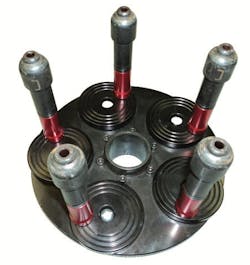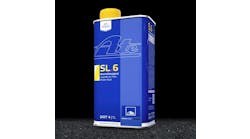Equipment suppliers agree that the biggest obstacle to properly balancing any type of wheel is not centering it correctly on the balancer. A variety of adapters are available to help technicians center a wheel. Modern Tire Dealer asked suppliers which adapters are essential, which are optional, and why. Jon Barganier, vice president of sales and marketing at Allpart Supply Inc.; Joe Atteo, product manager for wheel service equipment at Bosch Automotive Service Solutions; and Greg Meyer, product manager for wheel balancers at Hunter Engineering Co., responded.
Allpart Supply: It is always necessary to have a hub centering device (cone, collet, backing plate/disc) to replicate the wheel-to-hub mount from the vehicle on the balancer. This is the most critical part of properly mounting wheels on balancers so they are centered, thus producing accurate balancing results.
It is also recommended to always use a lug centering device (quick plate, flange plate over standard pressure cups) so the vehicle’s lug mount is replicated on the balancer. Haweka brand QuickPlates and/or flange plates provide even pressure and enough torque from the front of the wheel to push the wheel into a premium mounting position on the hub centering device, ensuring accurate results.
A Haweka Soft Grip Quick Nut or wing nut is required to tighten and hold the adapters and wheel in place on the balancer.
Wheels should never be front cone mounted on the balancer if accurate results are important to the tire shop. No wheel can be accurately balanced from front cone mounting.
For open housings or mid-centering devices, a spring must always be used when mounting wheels (or wheels will be front cone mounted).
A spacer and donut are required for larger collets on open mid-centering devices or collets will bottom out from touching the open walls of the mid-centering device. A spacer and donut are also required on dually applications with deep rims to prevent the wheel from being mounted too far back on the balancer.
Cones, pressure cups and a quick nut or wing nut are usually standard equipment with balancers. Some balancers come with an upgrade of two-sided, low taper collets rather than cones.
There are optional accessories to address clads, comebacks, weight chasing, etc. For hub centering (passenger car, light truck, SUV) there are two upgrade choices: low taper, two-sided collets (better); and Haweka brand Duo Expert no-taper, expandable collets (best).
There are also two accessory choices for lug centering (passenger car, light truck, SUV): flange plates (better); and Haweka brand QuickPlates (best).
Soft Grip Quick Nuts from Haweka speed up fastening the wheel and adapters to balancers, provide better grip on the shaft, require turns before quick release can be triggered (reducing pressure before release), and have a built-in torque ring and heavy pressure cup.
Two collets are very highly recommended for all tire shops. The Haweka brand Toyota precision collet is a problem-solving adapter for Toyota Tundra, Sequoia, Tacoma, 4Runner and FJ applications. The Haweka brand Ford precision collet is a problem-solving adapter for Ford light trucks, F-150s and SUVs.
For medium-duty (MD) wheels, especially since the conversion from 8x6.5 to metric hub diameters, MD adapter kit upgrades are a highly recommended optional upgrade over standard light truck cone kits. Hub adapters should be exact replicas of the MD wheel hubs Also, pin plate lug adapters should always be used on these wheels.
Bosch: Absolutely necessary is a variety of cones for wheel balancing compatibility and accuracy, in addition to keeping them clean. Cleanliness is vital for sustained accuracy when balancing wheels, as is using the correct cone adapter.
As more wheels are manufactured to be lug-centric, a lug-centric centering device becomes an important, but optional, accessory.
Bosch offers speed plates to address clad wheel mounting issues by redirecting the pressure applied to the wheel from the center hole to the lug holes when mounting to the wheel balancer. This puts the weight of the wheel on the strongest part, the lug holes, rather than the weaker center hole.
Hunter Engineering: Traditional cones have a much higher taper than collets and often fail to properly center today’s modern wheels. Hunter suggests using low angle collets, which are shorter, do not protrude into the wheel bore as far and meet the wheel at the correct location.
Hunter’s BullsEye collets only drop half as far into the wheel bore, allowing the protruding portion of the collet to press against the hub spring and ensure proper centering. They can help eliminate setup errors and avoid damaging specialty assemblies. ■





